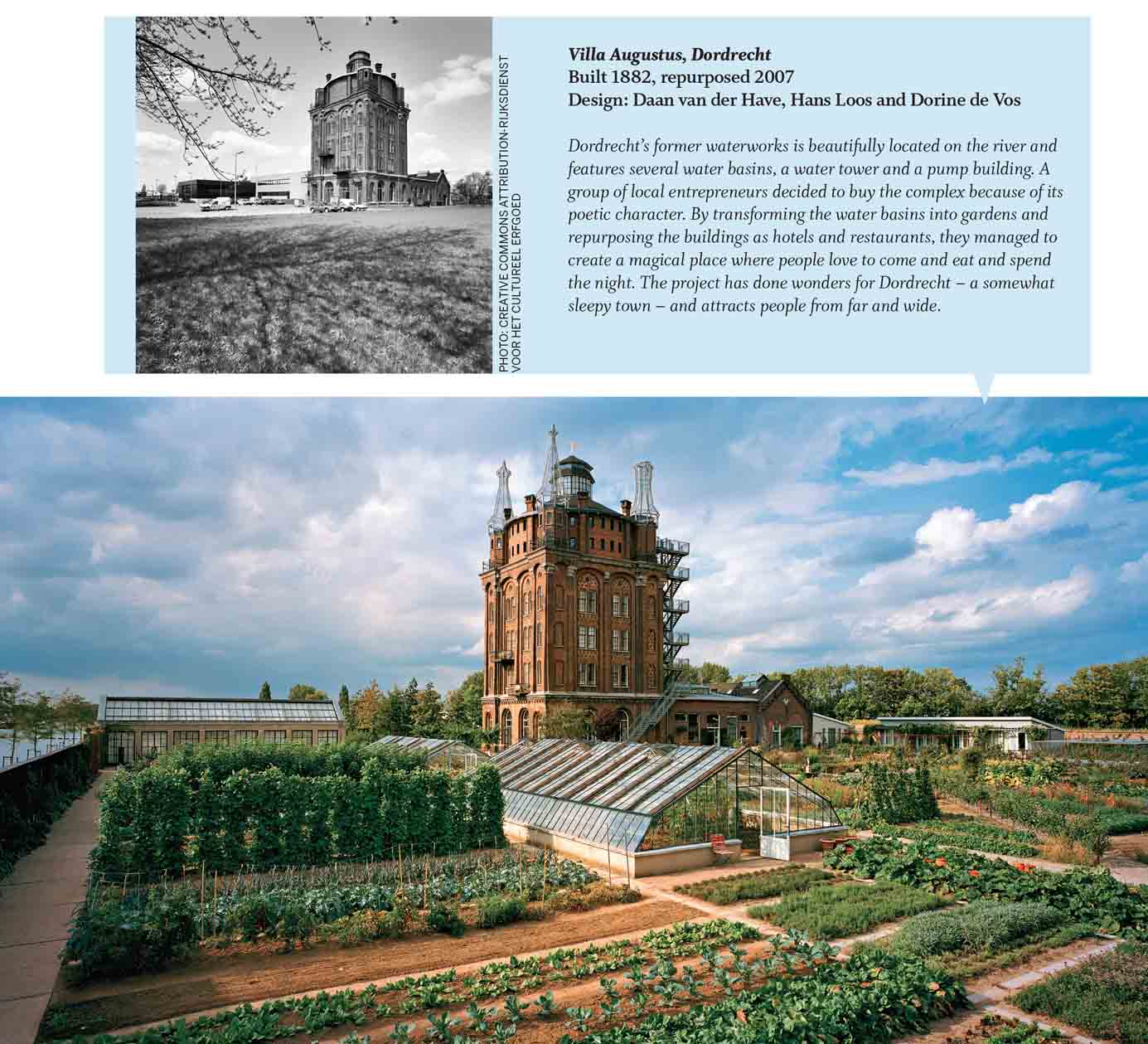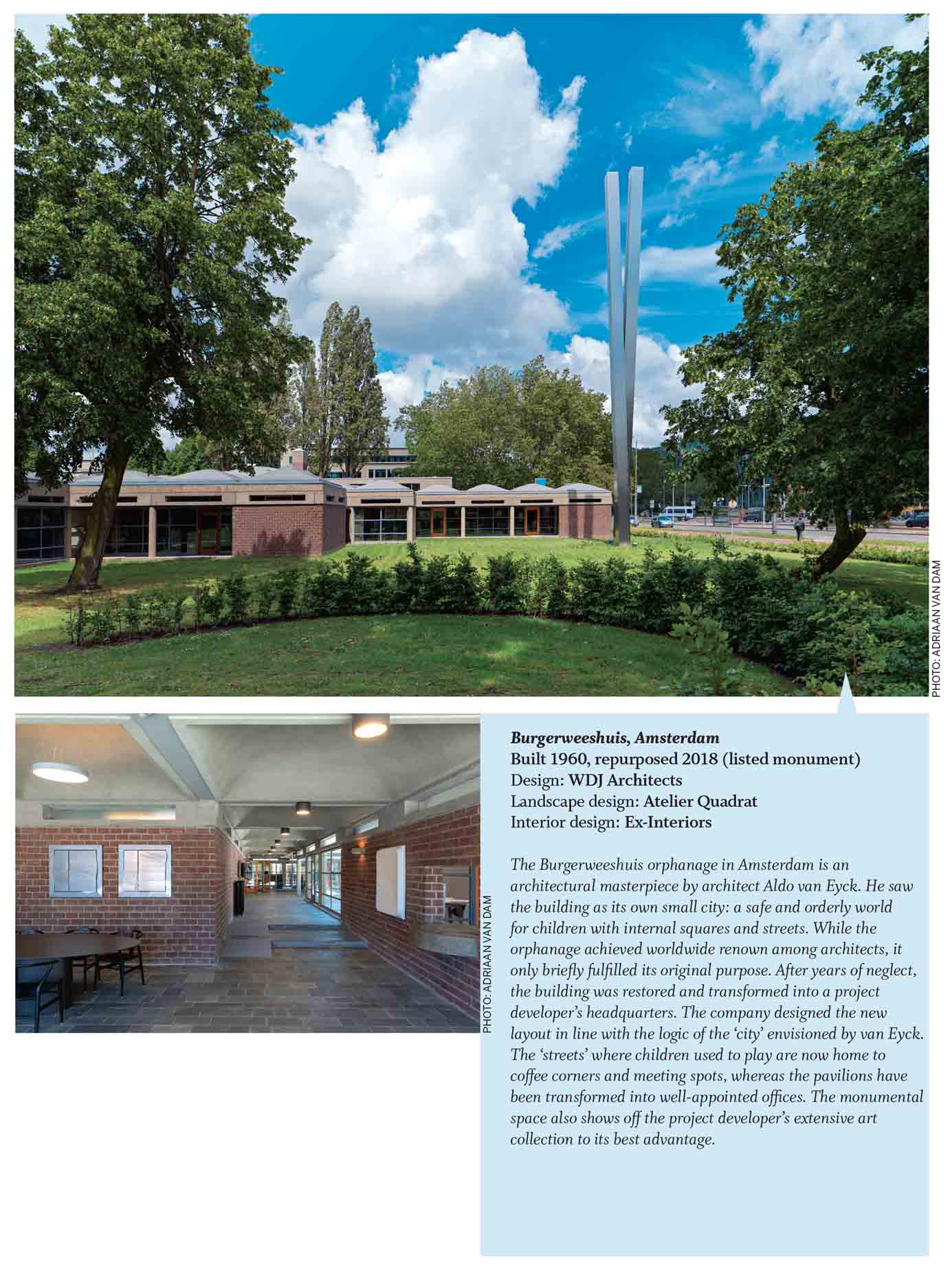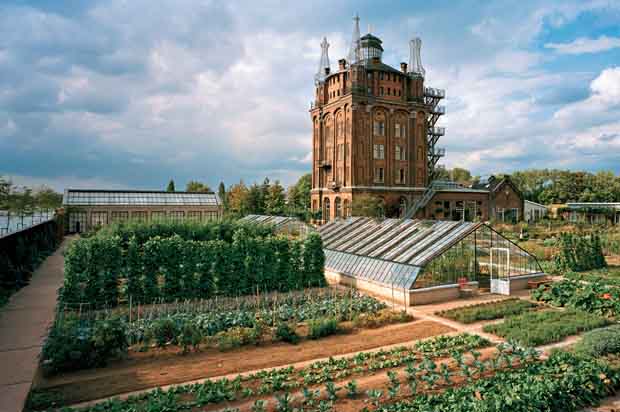Where there is empty space, there are opportunities for new use – opportunities the Netherlands cannot afford to waste, given the country’s urgent need for space: it is densely populated, travel distances are short and there is a social demand for city renovation that preserves existing quality. The creative industries in the Netherlands are leading the way when it comes to repurposing. They use their creativity to bring the right people together, to come up with surprising combinations of user functions, to devise financial solutions that make seemingly unprofitable ideas possible, to find smart new ways to preserve outdated buildings by making them more sustainable and, of course, to create designs that celebrate heritage by repurposing and updating it in ways that respect its cultural-historical value.
What is striking about the Dutch approach is how heritage has become an integral, mature and organic part of decision-making in spatial planning and urban development. Heritage is part of people’s daily living environments, and it is always considered when drawing up plans for the future. The old and the new are interwoven in many different ways. As a result, drastic changes to historic buildings are sometimes accepted. This fits in with how the Dutch see their country: as a layered cultural landscape with deep roots reaching back to previous centuries and also as a product of human ingenuity – as a landscape that is constantly changing but always remains recognisable. It should also be noted that repurposing is not limited to the creative class
in the Netherlands. It affects people of all ages, social classes and demographics, in both urban and rural areas.
The ‘Dutch’ approach to heritage is set out in the book Reuse, Redevelop and Design: How the Dutch Deal with Heritage, from which this article has been derived. The book was commissioned by the Dutch Ministry of Education, Culture and Science’s Cultural Heritage Agency as a way to start a dialogue about heritage with partner countries. Of course, approaches to heritage will differ depending on factors such as time and place, and the current repurposing trend in the Netherlands has a number of fashionable traits, which will probably evolve moving forward. That is why it is important to always be open to alternative approaches, and the best way to do that is to remain in constant dialogue. Reuse, Redevelop and Design is currently on a world tour, accompanied by an exhibition. At each stop of the tour, discussions are held on the basis of relevant current examples. Elsewhere in this magazine, you can read a report on one of our jointly hosted workshops in Jakarta.
Heritage is part of people’s daily living environments, and it is always considered when drawing up plans for the future
The discovery of everything that already exists
Repurposing is not new – it has been happening since the dawn of history, across cultures. One layer at a time, century by century, cities and villages have modernised. In the past, old building materials, outdated buildings and altered city structures were adapted to new uses in clever and organic ways. At some point in the last century and a half, however, organic reuse fell by the wayside. Growth and social changes were so rapid that modern industrial cities could not organically expand around existing structures. A different approach to spatial planning and building emerged, based on growth, innovation, standardisation and economies of scale. Building became synonymous with new build. Vacancy was usually the last stage before demolition and new construction, as entire city districts and landscapes were razed and rebuilt. Opportunities for redevelopment were either overlooked or dismissed as idealistic and unaffordable, and therefore unrealistic. Only large listed buildings were given special treatment. They were renovated and transformed into museums and high-end office buildings – transformations made possible by a large number of grants.

In the 1970s, social dissatisfaction with the large-scale demolition of city centres started to increase. It was an era in which common beliefs and practices were challenged. In 1972, the influential Club of Rome report, The Limits to Growth, added a new dimension to the environmental debate, while the 1975 European Architectural Heritage Year changed the way we viewed heritage sites. Citizens became protective of their cities, which led to fierce protests against demolition and large-scale redevelopments, as well as to initiatives to restore old buildings and give them a residential use. This development was in line with the international rediscovery of existing cities, propelled by publications in various countries: in the US Kevin Lynch’s The Image of the City (1960) and Jane Jacobs’ The Death and Life of Great American Cities (1961); in the UK Gordon Cullen’s Townscape (1961); and in Italy Aldo Rossi’s The Architecture of the City (1966). None of these authors were against urban renewal; rather, they argued for redevelopment based on existing social and physical logic of the cities.
The protests and proposed urban planning alternatives led to the realisation that old buildings can be used as homes and offices, and that historic centres hold a unique significance in modern and postmodern cities. As it turned out, many people would rather live in a historic building than a brand-new home. Looking for a unique place to live, they discovered old warehouses, vacant school buildings and abandoned bulb and tobacco barns – even though it would take some DIY home restorers years of their lives to turn these buildings into the palatial homes they are today. Professional developers also entered the repurposing market. They focused on larger and more complex projects, such as the redevelopment of factories and office buildings.
The challenge is to give redundant buildings a new use or to adapt them in such a way that they become suitable for their original use again
The repurposing challenge
Great examples of repurposing can be found all over the world, such as the Meatpacking District in New York, Puerto Madero in Buenos Aires, SESC Pompéia in São Paulo, 798 Art District in Beijing, the Albert Dock in Liverpool and Emscher Park in Germany. The Netherlands has had its fair share of iconic repurposing projects as well, but there have also been a uniquely large number of small-scale redevelopments. As a result of economic and social changes, many thousands of buildings have lost their original function: farmhouses, offices, churches, convents, factories, department stores, warehouses, pumping stations, school buildings, railway stations, shops, community centres, town halls, etc. It seems only natural to explore how all these buildings could be given a new life with a different use. Some distinctive characteristics of the Dutch approach to repurposing are its integral nature, the close cooperation between public and private parties, a strong focus on community involvement, market-oriented heritage care (‘conservation through development’) and market parties with a sense of cultural heritage and spatial identity.
Transformation requires both physical and social engineering: smart combinations of functions and users that produce synergy benefits and new forms of collectivity. Repurposing sometimes leads to surprising forms of mixed use – offices alongside a restaurant, a theatre inside a former church or a complex comprising artist studios, a café, a museum, shops and a theatre. It also allows people to live and work in buildings that have been made suitable for new uses in ways that fit their surroundings. Repurposed buildings often serve as so-called placemakers, catalysing the redevelopment of city districts by functioning as familiar and recognisable landmarks. The Netherlands’ construction challenge has become a repurposing challenge. In the words of Jane Jacobs: ‘Old ideas can sometimes use new buildings. New ideas must use old buildings.’


Changed market
The challenge is to give redundant buildings a new use or to adapt them in such a way that they become suitable for their original use again – in technical, economic and social terms. The number of large companies and multinationals has decreased, and more people are self-employed. They are part of large networks and can work online from anywhere in the world. Today’s property users want flexibility, interchangeability, variety, sustainability and social cohesion. There is a demand for residential and office concepts that integrate a building’s history, as well as the distinct qualities of its surroundings.
The City of Rotterdam, for example, designated a number of fixer-upper houses: dilapidated listed buildings to be sold at low prices, on the condition that the buyers immediately start investing in renovations. The supporting structures and building shells were overhauled by a contractor, but the buyers had to finish their new homes themselves. The experiment was especially attractive for first-time home buyers and helped keep university-educated young people in the city. For millennials, living in a renovated railway building makes much more sense than moving to a brand-new home in the suburbs. The elderly are also an important target group: many of them want to move back to the city – or move there for the first time – where they feel safe and care facilities are nearby. Outdated office buildings from the 1960s and 1970s, which until recently were widely regarded as eyesores, are often ideal for conversion into housing for specific target groups. And once they have been given a new lease on life, they often – against all expectations – become beloved and cherished homes. Of course, it is impossible and undesirable to preserve every single building. Poorly constructed offices in bad locations will eventually have to be torn down, expensive though that may be.
For millennials, living in a renovated railway building makes much more sense than moving to a brand-new home in the suburbs
Flexibility and diversity
The conversion of derelict buildings provides unforeseen opportunities for special uses. It starts with bringing together supply and demand, initiators and spaces. Given the fact that the buildings in question were not designed for their new use, adjustments and additions are inevitable. The space must adapt to its use and to its users, and vice versa. This requires a case-by-case approach. The designs have to be functional, feasible and affordable, and they must meet all relevant building standards and regulatory requirements.
In the past, repurposing projects were often initiated by the government, and usually involved large-scale interventions. The financial deficit (‘the unprofitable top’) would be compensated through subsidies because of the expected upsides, such as area development and social benefits: increased cultural diversity, area upgrading, an influx of high-earning households or the retention of social target groups. Today, the government takes a different approach, as it tries to encourage repurposing by removing as many obstacles as possible for private investors.


New challenges
The government’s change of direction is in line with a general rethinking of government’s roles and tasks in society. Builders, architects, the historic preservation community and the general public have adapted their roles accordingly. The heritage sector is changing as well. Government institutions sometimes have reservations about issuing permits for repurposing projects that will change the character of a building and add new qualities, as this will have an effect on its historic value. How much can a historic building change before it loses its soul and integrity? The challenge for the heritage sector is to learn to welcome new developments while remaining firm in protecting listed properties against threats to their essence. Developers, on the other hand, must take a risk by investing in a process of which neither the outcome nor the yield (and profit) are certain in advance. The government can provide support in this, but the new financing and exploitation models that are currently being developed will also help address this issue.
The challenge for architects is to design based on existing cultural values instead of starting from scratch. This requires a specific design approach. Meanwhile, the government is taking a critical look at the existing laws and regulations, which are often designed specifically for new-build projects, and which can interfere with effective redevelopment. Reuse requires flexible rules – without creating an irresponsibly dangerous situation or negative effects on the environment. Finally, the role of citizens has also changed. They are now well organised – socially, politically and legally – and are increasingly able to make their voices heard. Involving them in processes and assigning them joint responsibility for the results can unlock significant creativity, knowledge and support. Like shapeshifters, squatters have changed into developers, local residents have turned into project initiators, and yesterday’s demolition companies are today’s redevelopers. This is the last necessary step towards a truly integrated approach to repurposing, in which specialists, policymakers and stakeholders work together, each with their own role, responsibility and expertise.



Comments (0)